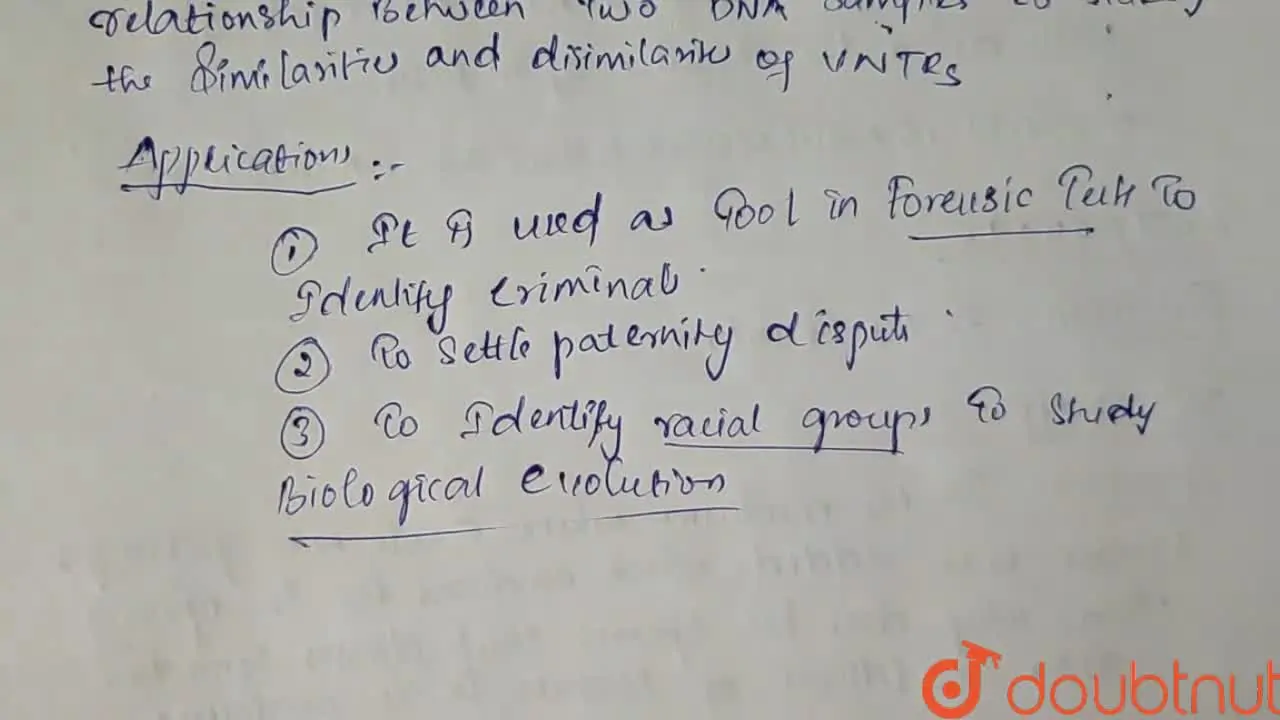What is DNA fingerprinting? Mention its application.Solution in Telugu
DNA fingerprinting is a method for identifying individuals by the particular structure of their DNA.
Human DNA consists of 3 billion nucleoticdes, 90% of which ale identical-among all individuals. No two people have exactly the same sequence of base In their DNA. Restriction fragment length polymorphist are characteristic to every person DNA. They are called Variable Number Tandem Repeats (VNTRs) and are useful as "Genetic markers. The VNTRs of two persons generally show variations. DNA finger pitting involves in dentifying differences in some specific regions in DNA sequence called repetitive DNA. These sequences show high degree of polymorphism and form the basis of DNA finger printing. Protocol of DNA finger printing.
Protocol of DNA finger printing:
1. Obtaining DNA: DNA sample is collected from the blood, saliva hair roots, semen etc. If needed many copies of the DNA is amplified by using PCR
2. Fragmenting DNA (or) Restriction Digestion : DNA sample is treated with restriction enzymes to cut the DNA at a specific sites and form smaller fragments.
3. Separation of DNA fragments by electrophoresis : By using ag4rose gel electrophoresis the DNA fragments are separated bated on their charge and molecular weight.
4.Denaturing DNA : The DNA on the gel is denatured to form single stranded DNA strands using alkaline chemicals.
5.Blotting : A thin nylon membrane is placed over the size fractioned DNA strands. and covered by paper towels. As the towels draw moisture the DNA strands are transferred on to the nylon membrane by capillary action. This process is called blotting.
6. Using probes to identify specific DNA : A radio active probe is .added to the DNA bands. The probe is a single stranded DNA molecule that is complementary to the gene of interest in the sample under study. The probe attaches by base pairing to those restriction fragments that are Complementary to its sequence.
7. Hybridization with probe: After the probe hybridizes, the excess-probe is washed off by washing. A photographic film is placed on the membrane containing DNA hybrids.
8. Exposure on film to make a DNA finger print : The radioactive label exposes the film to form an image in the form of binds corresponding to specific DNA bands. These bands forma pattern of bars which constitute a DNA finger print.
Applications of DNA finger-printing:
1. 1. Conservation of wild life : Protection of endangered species, by maintaining their records for identification of tissues of the dead endangered organisms.
2. Taxonomical applications : Study of Phylogeny
3. Pedigree analysis : inheritance pattern of gene through generations.
4. Anthropological studies : Charting of origin and migration of human population.
5. Medico-legal cases : Establishing paternity and or maternity more accurately.
6.Forensic analysis : Positive identification of a suspect in a crime.
Related Playlists
- BOOK - VIKRAM PUBLICATION ( ANDHRA PUBLICATION)CHAPTER - GENETICS EXERCISE - IMPORTANT QUESTIONS13videos
GENETICS
- BOOK - VIKRAM PUBLICATION ( ANDHRA PUBLICATION)CHAPTER - GENETICS EXERCISE - SHORT ANSWER QUESTIONS18videos
GENETICS
- BOOK - VIKRAM PUBLICATION ( ANDHRA PUBLICATION)CHAPTER - EXCRETORY PRODUCTS AND THEIR ELIMINATIONEXERCISE - LONG ANSWER QUESTIONS2videos
EXCRETORY PRODUCTS AND THEIR ELIMINATION
- BOOK - VIKRAM PUBLICATION ( ANDHRA PUBLICATION)CHAPTER - HUMAN REPRODUCTIVE SYSTEM EXERCISE - IMPORTANT QUESTIONS15videos
HUMAN REPRODUCTIVE SYSTEM
Similar Questions
What is Pleiotropy?
04:38View SolutionBriefly mention the contribution of T.H. Morgan in genetics.
07:00View SolutionDescribe the structure of kidneys.
04:12View SolutionDefine spermiogenesis and spermiation.
03:50View SolutionWhat is DNA fingerprinting? Mention its application.
05:09View SolutionDNA फिंगर-प्रिंटिंग क्या है? इसके मानव हित में उपयोग का उल्लेख कीजिये।
02:44View SolutionDNA फिंगरप्रिंटिंग के अनुप्रयोगों की सूची बनाइए।
01:46View SolutionDiscuss various applications of DNA fingerprinting.
04:20View SolutionWhat is DNA fingerprinting? Mention its application.
07:44View SolutionMention any three applications of DNA finger printing technique.
04:21View SolutionMention any two application of DNA fingerprinting.
05:48View SolutionWhat is DNA fingerprinting? Mention its application.
03:24View SolutionWhat is DNA fingerprinting? Mention its applications
03:01View SolutionWhat is DNA fingerprinting? Mention its application.
01:21View SolutionDNA ফিঙ্গারপ্রিন্টিং-এর ব্যবহারিক প্রয়োগ উল্লেখ করো | DNA প্রোব বলতে কী বোঝ ?
01:52View SolutionWhat is DNA fingerprinting ? Mention its applications.
View Solution


